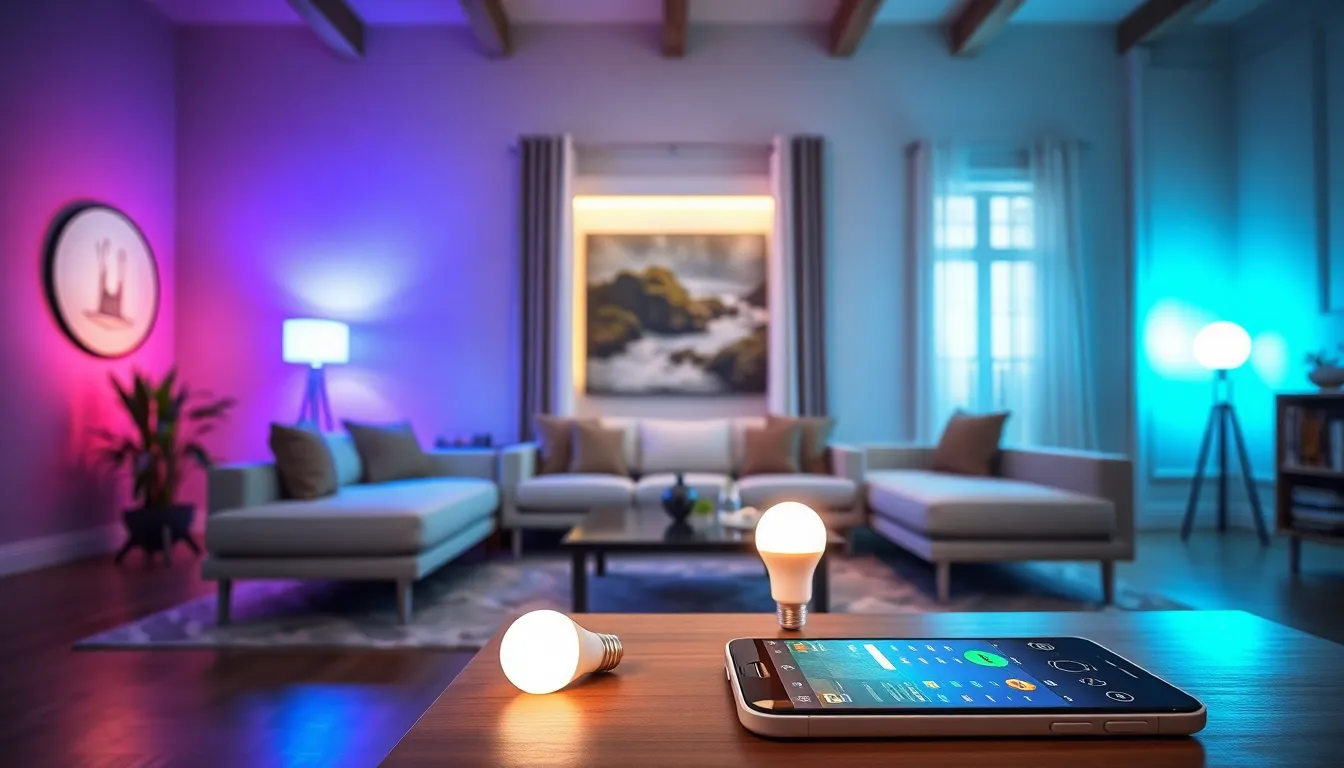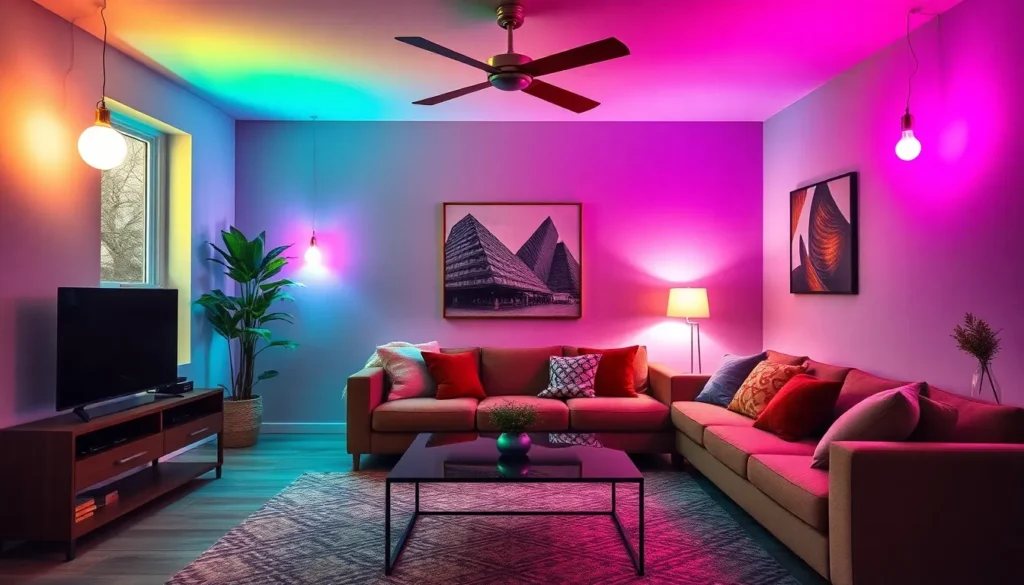Table of Contents
ToggleImagine walking into a room and instantly setting the mood with just a tap on your phone. WiFi smart bulbs are here to turn that dream into reality, making lighting as easy as scrolling through your social media feed. Gone are the days of fumbling for switches in the dark or arguing over which light is too bright or too dim.
Overview of Wifi Smart Bulbs
WiFi smart bulbs represent a significant advancement in home lighting technology. These bulbs connect to a home network, enabling users to control them via smartphone apps or voice commands. Offering versatility, smart bulbs often feature adjustable brightness and color settings, allowing for personalized lighting experiences.
Smart bulbs typically use LED technology, ensuring energy efficiency and longer lifespan compared to traditional incandescent bulbs. They operate on 2.4 GHz or 5 GHz WiFi bands, which facilitate seamless connectivity. Users can install them in standard light fixtures, making integration into existing home setups straightforward.
Compatibility emerges as a critical factor for consumers. Many smart bulbs work with popular smart home ecosystems such as Amazon Alexa, Google Assistant, and Apple HomeKit. This compatibility allows for voice-activated control and integration into automated routines. Users can manage multiple bulbs from a central app, providing enhanced convenience.
Moreover, features like scheduling and remote access set smart bulbs apart. Users can program them to turn on or off at specific times, promoting energy savings and added security while away from home. Some models also offer motion sensors or ambient light detection, further optimizing performance.
In terms of aesthetics, smart bulbs come in a range of shapes, sizes, and designs. Some consumers prefer a classic bulb appearance, while others opt for modern, decorative designs that enhance home decor. These design choices ensure that lighting solutions remain not only functional but also visually appealing.
Benefits of Using Wifi Smart Bulbs

Wifi smart bulbs offer numerous advantages, enhancing convenience and energy savings for households. Several notable benefits stand out.
Energy Efficiency
Energy efficiency forms a core advantage of wifi smart bulbs. These bulbs utilize LED technology, consuming up to 80% less energy than traditional incandescent bulbs. An average 10-watt smart bulb can provide the same brightness as a 60-watt incandescent bulb. Lower energy consumption translates to reduced electricity bills, making smart bulbs a cost-effective lighting option. Lifespan comparison reveals smart bulbs typically last up to 25,000 hours, significantly outlasting conventional bulbs that often last about 1,000 hours. As a result, homeowners not only save money but also contribute to environmental conservation.
Remote Control Features
Remote control capabilities define a major benefit of wifi smart bulbs. Users can manage lighting from any location using smartphone applications. Control options often include brightness adjustment, color changes, and schedules. Advanced features, like integrating with home automation systems, enhance user experience, allowing for custom lighting scenarios without physical presence. Voice command compatibility offers additional convenience, with many smart bulbs integrating seamlessly with popular systems like Amazon Alexa and Google Assistant. This level of control ensures that lights can be turned on or off even while away from home, increasing security and flexibility.
Features to Consider
WiFi smart bulbs offer diverse features that enhance their utility and compatibility with modern living. Evaluating specific aspects ensures optimal choices for lighting solutions.
Compatibility with Smart Home Systems
Smart bulbs integrate seamlessly with popular smart home systems like Amazon Alexa, Google Assistant, and Apple HomeKit. Users enjoy voice-activated control through these platforms, making everyday tasks easier. They simplify home automation setups by syncing with other smart devices. Integration allows for lighting routines that enhance security, ensuring lights turn on or off automatically when users are away. Compatibility reduces the need for multiple apps, centralizing control for convenience.
Light Color and Brightness Options
WiFi smart bulbs provide adjustable brightness and a wide spectrum of colors, allowing users to customize their lighting experiences. Many models feature millions of color options to suit various moods or activities. Brightness settings enhance functionality, accommodating tasks from reading to relaxing. Users can set different scenes, making it easy to transition between work and leisure. Flexibility in color and brightness enriches the ambiance of any room, promoting both creativity and comfort.
Popular Wifi Smart Bulb Brands
Philips Hue remains a top choice for many users. It offers an extensive range of colors, customizable lighting schedules, and robust integration with smart home systems. Users appreciate its reliability and quality.
LIFX provides vibrant colors with high brightness levels. This brand operates without a hub, directly connecting to WiFi, which simplifies installation. Many consumers admire its sleek designs and wide variety of smart bulb options.
TP-Link Kasa is noted for its affordability and solid performance. It includes essential features like scheduling and remote control. Users often choose it for easy integration with Amazon Alexa and Google Assistant.
Wyze offers smart bulbs at competitive prices. Its products deliver essential features and impressive brightness levels. Many users find it an attractive option for budget-conscious shoppers without sacrificing functionality.
Sengled specializes in smart lighting solutions compatible with various smart home systems. It features both traditional bulbs and unique designs, appealing to diverse aesthetic preferences. This brand’s strong focus on energy efficiency provides additional savings for users.
Ring, primarily known for security, also offers smart lighting solutions. Its smart bulbs integrate seamlessly with other Ring devices. This integration enhances home security while providing customizable lighting options.
Ecobee stands out with its smart home ecosystem. Known for smart thermostats, it also offers smart bulbs that can be controlled remotely. Users benefit from its commitment to energy efficiency and easy-to-use app interface.
Each brand presents distinct features and advantages. When selecting a smart bulb, individuals often consider factors like compatibility, design, and price to meet their specific lighting needs.
WiFi smart bulbs represent a significant leap in home lighting technology. Their energy efficiency and versatility not only reduce electricity costs but also enhance the overall living experience. With features like remote access and voice control, these bulbs offer unparalleled convenience and customization.
As consumers explore options, brands like Philips Hue and LIFX provide unique advantages tailored to various needs. The ability to integrate seamlessly into existing smart home ecosystems further solidifies their appeal.
Investing in WiFi smart bulbs is a smart choice for anyone looking to elevate their home lighting while enjoying the benefits of modern technology.







